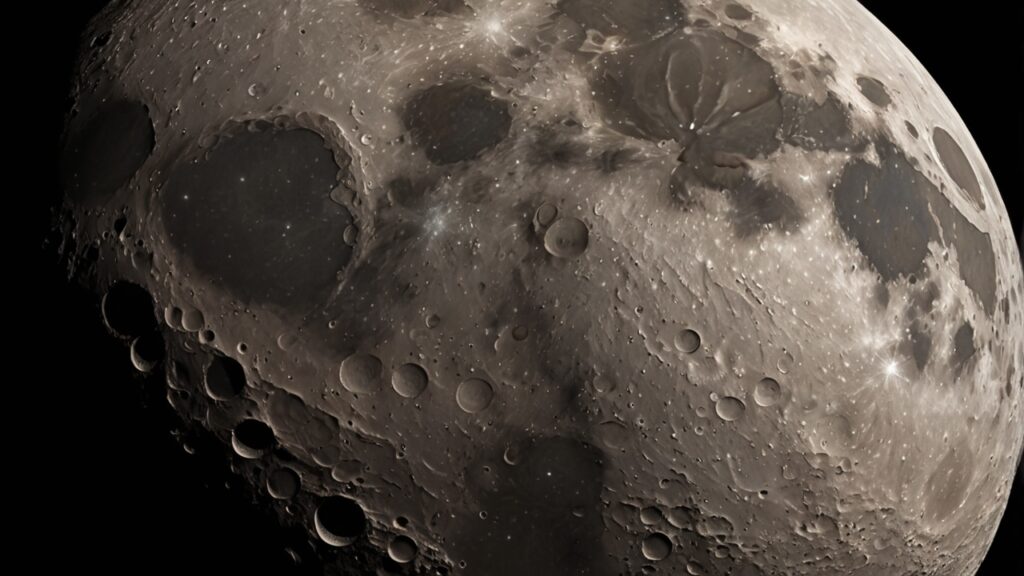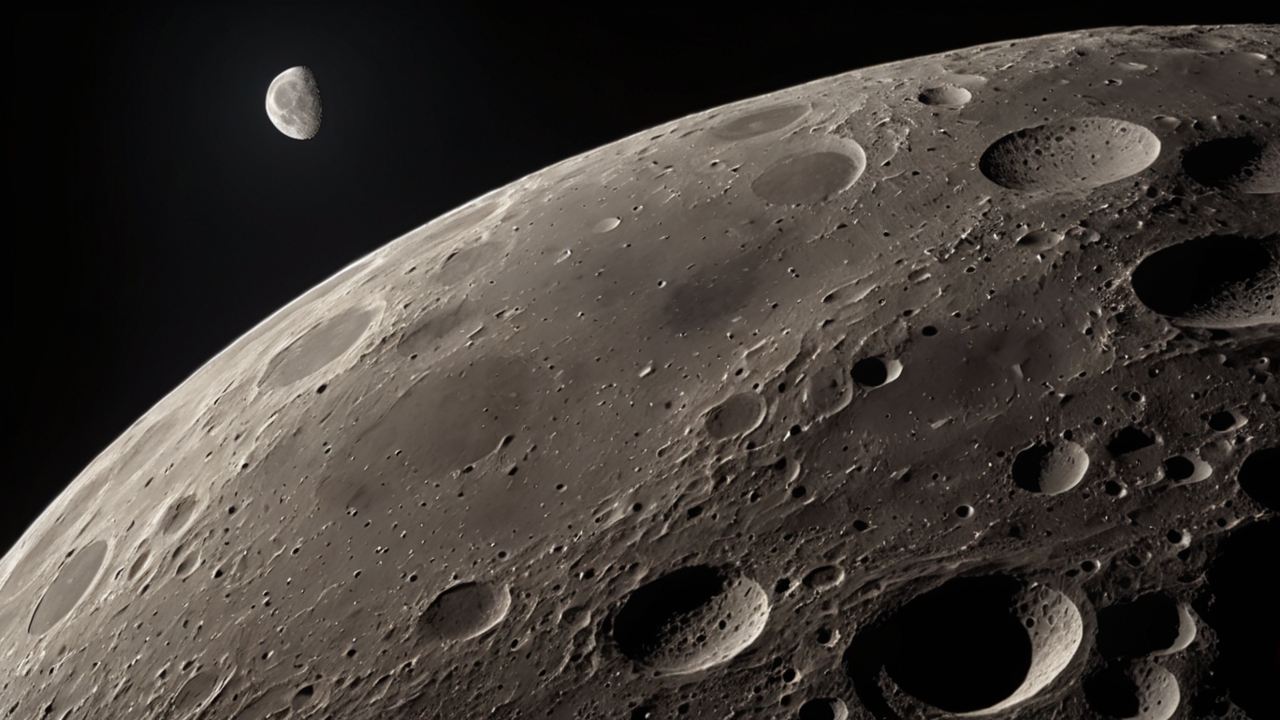Introduction
Just imagine that it’s a quiet night. You walk in your backyard and look up and see the Moon shining, But wait what are those dark spots on the moon they’re not just random marks rather they are huge creators on the surface of the moon made by asteroids crashing into the Moon from billions of years. Those creators are older than the era of dinosaurs. For thousands of years, humans have stared at these black marks on the moon. Galileo saw them through his telescope in 1609 and concluded that the moon wasn’t a perfect sphere.
Here’s the best part: when you see the moon from your rooftop You don’t need Galileo’s genius (or huge budget) to see what he saw. With this guide, you’ll learn to:
- Find jaw-dropping craters by using just your eyes or some low-budget binoculars.
- Understand the mythical stories they tell.
- Every time you look up to the moon you will find or learn something new about the Craters.
Why Craters More Than Just a Cosmic Pothole
Craters are not “holes.” rather they’re time capsules.
- 4.5 Billion Years of History: The time when our earth and moon formed from that time to this day you see a crater, you’re looking at wreckage from the Late Heavy Bombardment an era when asteroids rained down on the Moon and earth. The Moon preserved these impacts because it has no atmosphere that can cause (wind, water, or earthquakes to erase them).
- Beauty in Chaos: When Sunlight hits the moon’s surface it transforms craters into dramatic landscapes. Near the “terminator” (the line separating day from night on the Moon), shadows stretch like black ink, showing canyons, cliffs, and peaks.
- Beginner-Friendly: The Moon is near a celestial body Unlike faint galaxies, and is easy for us to spot the Moon its brightness, is easy to find, and we can study it in detail. No dark skies are needed for that.
Fun Fact: The largest crater on the moon is, “South Pole-Aitken Basin,” which is 1,550 miles wide its wide enough to stretch from New York City to Denver. How exciting is that?
Gear Up Simple Tools for Cosmic Discovery
Level 1: Naked Eye (Zero Cost)
- What You’ll See: Dark splotches (Maria ancient lava plains) and bright zones.
- Your First Target: Tycho Crater. At the Full Moon, it looks like a white “starburst” near the bottom of the moon.
Level 2: Binoculars (Game-Changer)
- Ideal Pair: 7×50 or 10×50 magnifications cost you around ($30-$80).
- Pro Tip: Rest elbows on a car roof or roof wall to stop shakes. Suddenly, the Moon shows its full detail.
- What You’ll See: Craters as small as 50 miles across, mountain ranges, and bright “rays” from impacts.
Level 3: Telescope (Next-Level Adventure)
- Starter Scope: A 70mm-90mm refractor cost you around ($150-$250).
- Eyepiece: Start with 20mm-25mm for wider and better views.
- Transformative Moment: Copernicus Crater becomes a 60-mile-wide bowl with terraced walls and a central mountain.
Read More about Binoculars and Telescopes for beginners Click Here
Essential Extras
- Moon App: you can use LunarMap HD (free) to show real-time crater names.
- Red Flashlight: it is better to preserve night vision (wrap your flashlight in red plastic).
- Notebook: write down the names of craters and sketching sharpens your eye.

When & Where to Go: Timing Is Important
Phase Matters Most
- Avoid: Full Moon (There will be no shadows = flat, glaring “pancake”).
- Perfect: First Quarter (half-moon, evening) or Last Quarter (half-moon, dawn).
- Why?: Near to the terminator, the low Sun could cast long shadows. Craters look 3D like canyons carved from light.
Location Hacks
- City-Friendly: Moon is bright Even from a balcony, you’ll see craters.
- Avoid “Heat Waves”: Don’t observe over rooftops/roads because warm air causes a blurred view.
- Check Moonrise: you can use apps like SkySafari to plan sessions.
Your First Crater Hunt: A Step-by-Step Guide
Step 1: Learn the “Landmarks”
- Maria (Seas): Dark and smooth plains. Mare Tranquillitatis = Apollo 11’s landing site.
- Bright Highlands: Ancient and crater-battered terrain.
Step 2: Target the Terminator
This shadow line is your “sweet spot.” Shadows exaggerate depth a 2 mile-tall mountain casts a 100-mile shadow
Step 3: 5 Must-See Craters (Beginner Edition)
1. Tycho
- How you can find: Southern highlands. Looks like a white flower with “rays.”
- Why This Awesome: These are Young (108 million years old), with debris sprayed over 1,000 miles.
2. Copernicus
- How to Find: Dead center of the Moon. A deep pit with a sunken mountain.
- Why Awesome: Called the “Monarch of the Moon” visible in binoculars
3. Plato
- How to Find: Near the North Pole. A dark, smooth floor (like a volcanic lake).
- Why Awesome: Easy to spot. Watch for tiny craterlets on its floor!
4. Clavius
- How to Find: South of Tycho. A massive 140-mile-wide “bullseye.”
- Why Awesome: Contains a chain of smaller craters—like pearls on a necklace!
5. Albategnius
- How to Find: Near the center. Classic crater with terraced walls.
- Why Awesome: Perfect example of an “impact scar.”
Play Lunar Detective What to Notice
- Walls: Steep? Collapsed? Terraced like a stadium?
- Floor: Flat? Cracked? Covered in boulders?
- Central Peak: A mountain pushed up by the impact?
- Rays: Bright streaks? (Tycho’s stretch halfway across the Moon!)
Pro Techniques: See More, Learn Faster
- Dark Adaptation: Wait for 15 mins in darkness your eyes will gain “super-vision.”
- Averted Vision: Look slightly beside a faint crater. Your peripheral vision sees better in low light
- Sketching: Even a 30-second doodle will train your brain to spot more details.
- Beat the “Wobbles”: If the Moon shimmers, wait for moments of calm air.
- Moon Filter: Attach to telescopes to cut glare during bright phases.
Beyond Craters: Mountains, Valleys & Ghost Volcanoes
- Montes Apennines: A 400-mile mountain range and cliffs cast dagger-like shadows
- Vallis Alpes: A 110-mile “crack” which is splitting a lunar plateau.
- Domes: Gentle bumps remnants of an ancient volcano. Like near crater Hortensius.
Keep a Moon Journal: Your Personal Lunar Log
Why? Your notes become a treasure map for future you.
Sample Entry:
Date: June 5, 2025
Time: 9:15 PM
Moon Phase: First Quarter
Gear: 10×50 Binoculars
Seen: Copernicus! The central peak looked like a tiny island. Plato’s floor was velvety black.
Sketch: Simple crater shapes + terminator line
Wow Moment: Found Clavius’s crater chain like diamonds on coal
Photography Tip: Tape your phone into binoculars for quick Moon shots!
Conclusion: Your Adventure Starts Tonight
You now have the keys to the Moon’s silent ancient world. Those are craters not just rocks. They are monuments of beauty and the power of space.
Tonight:
- Go to your Rooftop or some other where light pollution is low.
- Find the Moon.
- Grab binoculars and scan the terminator.
- Hunt for Tycho’s rays or Copernicus’s pit.
You’re not just looking—you’re exploring. Share your first crater sketch with #MoonCraterHunter and share it with your friends and family or related communities.
The same craters you see tonight inspired Galileo, Jules Verne, and Apollo astronauts.
Free Resources to Fuel Your Journey
- Apps: LunarMap HD (iOS/Android), SkySafari Free
- Moon Maps: NASA’s QuickMap (zoom in on craters!)
- Books: “The Modern Moon” (Charles Wood), “Nightwatch” (Terence Dickinson)
- Communities: r/moon (Reddit), Cloudy Nights Forums
